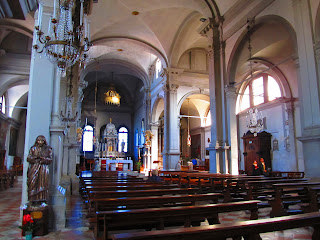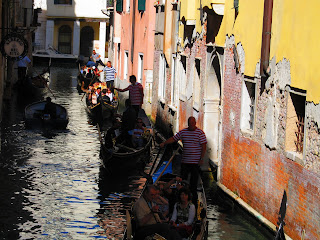We are acutely aware that we haven't blogged for a few days, but it's not because we can't be bothered or there's nothing to write about. In fact we are having a wonderful time, just relaxing and taking it all in, which was always our intention on this trip. We never intended to rush around "doing stuff", and that's the beauty of it.
In the mornings we get up around 8:00 or 9:00am and if we feel like it, we eat breakfast here in the apartment, which generally comprises cereal, toast and tea, but quite often we go to one of the nearby cafes called Brek, which is so ridiculously good that we repeatedly wonder why we ever have breakfast at home. One euro (about $AUD1.34) at Brek will buy you a wonderful coffee (any kind you like) and a pastry - this pastry comes served hot, freshly baked and you can choose either: a plain croissant, a flaky pastry filled with Nutella, a croissant filled with custard, a plain donut, jam-filled donut or custard-filled donut or a muffin. So, one euro = one coffee + one pastry. Does it get any better than that?
There's always something going on in Padua. We are happy to walk around the different market stalls every day and buy this and that while observing the "theatre".
Sometimes there will be a guy playing the piano accordian, or a juggler or a balloon artist. This morning there was a brass band - we don't know what the celebration was, but the uniform was interesting, featuring feathered hats and much pomp and ceremony.
I am enjoying cooking dinner most nights as I find the ingredients are of much higher quality than I am able to buy at home (even the eggs are better - so yellow and so fresh that I think they are laid on the day we buy them). I haven't cooked anything that I wouldn't have made at home, but we think the meals have been very good. We've also been sampling some AMAZING cheeses, sausages and breads here in Padua; I've never seen such a variety of smallgoods as we have seen in the marketplace here. Photos of a couple of the dishes I've prepared, follow:


Last Friday I went to see the synagogue here, hoping to just pop in for a moment, take a look around and then leave. I realised that it was Succoth, a special holy day in our calendar but I didn't think that would make a difference. An hour and a half later I emerged, having stayed for the whole service and been plied with sweet cake and wine, as well as being invited back to come again as often as I can. There were only 18 in the whole congregation but everyone was SO nice to me that I felt very welcome and included from the moment I arrived, when I was given a prayer book and shown which passage they were up to; it was all lovely. To travel to the other side of the world and find your own people waiting for you is very heartwarming.
We have been blessed with wonderful weather since arriving, with temperatures around 20 degrees each day as well as clear blue skies most of the time. It can be chilly in the evening but we came prepared for that and manage perfectly well with an extra jacket and scarf when we walk after dinner. Last night we walked to the piazza and bought gelati around 8:00pm but we came back to the apartment to eat it, as there was a bit of a cool breeze blowing and it was easier to just head back home. Most afternoons we sit in the piazza and have a glass of wine while doing some people-watching before we have dinner. There is quite a sport of that going on here, it seems. Many couples and small groups seem to do the same as we do, perhaps on their way home from work. There is a fellow roasting chestnuts in the piazza late each afternoon and we usually choose a spot where we can watch him throwing the huge pan in the air and chatting with everyone who walks by.

Today we made a day trip to a little town called Este, which is about 30 minutes away by train. It is an historical town with a castle, and every third Sunday there is an antique market in the piazza, so we thought that might be fun. It was OK, but not as good as we expected. It doesn't matter, though, because when you have a month to do things, there will be some days that are better than others. Here's the obligatory photo of the castle in Este, anyway:
Incidentally, for the first time today since our journey began, I heard the "f-word" and not just once but about 87 times. It wasn't an Italian saying it. A group of young Australian boys boarded our train, apparently on their way to watch a rugby game (?) in Verona. They were loud and obnoxious and every sentence was punctuated with swearing and carry-on. We were not proud.
Is it wrong to say that we're missing TV? We have about 300 stations on our TV but none of them is English-speaking. Sometimes in the evening you just want to sit down and watch a movie, a documentary or any old thing, but it's not possible. I'm grateful for having the Kindle with me, as I've read four books in the past two weeks and am nearly finished with my fifth.
OK, enough from me for now. Hope all is well, wherever you are reading this.
D1





















































